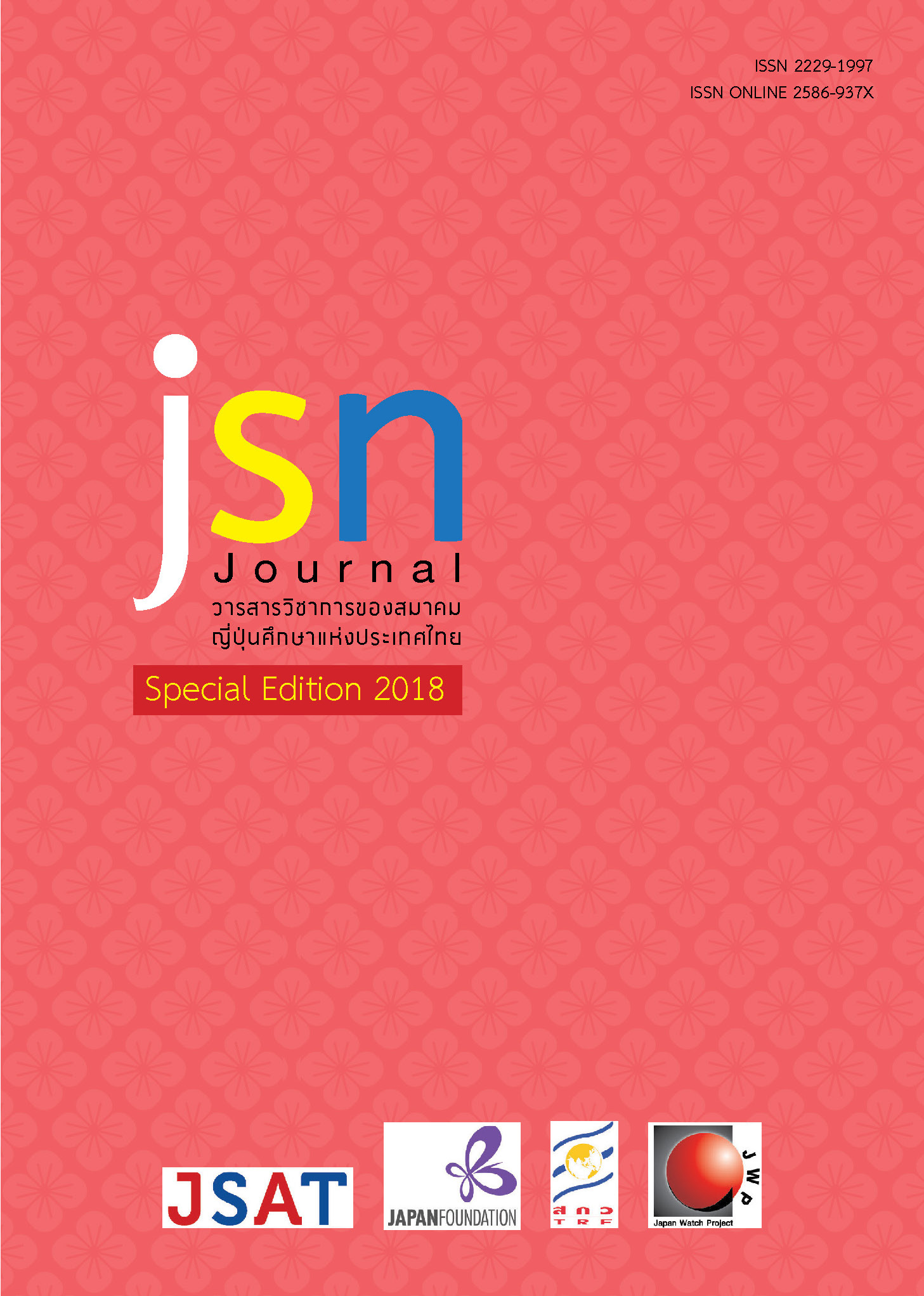The Effectiveness of Teaching ~そうです and ~ようです in Japanese through Pictures and The Learners’ Satisfaction
Main Article Content
Abstract
The objective of this study was to examine the effectiveness of using pictures as a means of teaching Japanese as a foreign language and the learners’ satisfaction of this teaching method.This research was quasi-experimental in design. Qualitative data was collected from in-depth interviews with three experts in order to create and develop instruments. The instruments were the course content for teaching そうです and ようです, a pre-test and a post-test, and a course content evaluation form to determine students’ satisfaction. Quantitative data was collected from a pilot test to determine the value of reliability, difficulty (p) and the discrimination (r). The participants consisted of two groups who studied through pictures and texts. The findings showed that there was a significant difference between the mean scores of the students’ pre-test and post-test from both groups (p = 0.001*), whereas the difference of the value of the mean from the pre-test and the posttest of both groups studying through pictures (M= 4.88) and texts (M= 2.25) was 2.63. The effectiveness index criteria of the group that studied through pictures was 0.52, over the 0.5 criteria, and was higher than the group that studied through texts which was at 0.24. In addition, the students’ satisfaction of the group studying through pictures using the course content of そうです and ようです was at 4.75 out of 5.00 higher than that of the group studying through texts at 3.80. The use of pictures was found to help the students overcome their problems in learning. Pictures could also motivate cognitive thinking of the similar grammar structures.
Article Details
ข้อความและข้อคิดเห็นต่างๆ ในบทความเป็นของผู้เขียนบทความนั้นๆ ไม่ใช่ความเห็นของกองบรรณาธิการหรือของวารสาร jsn Journal
References
Ariningsih, D. (2010). The effectiveness of using picture series to improve the students’ writing skill viewed from their Learning motivation (An experimental study in the seventh grade of SMPN 1 Tanjunganom Nganjuk in the academic year 2008/2009). Sebelas Maret University, Retrieved from file:///C:/Users/Administrator/Downloads/Dwi%20Ariningsih%20Pdf.pdf
Atachi, A., Umeda, Y., Kameda, H., Saito, N., Saito, Y., & Suguru, T. (2004). 絵で導入・絵で練習. Japan: Bonjinsha.
Banno, E., Ohno, Y., Sakane, Y., Shinagawa, C., & Tokashiki, K. (2003). An Integrated Course in Elementary Japanese Genki. Tokyo: The Japan Times.
Buzan, T. (2000). Use your head. London: BBC Worldwide Limited.
Carter, J. B. (2008). Comics, the canon and the classroom. In N. Frey & D. Fisher (Eds.), Teaching visual literacy: Using comic books, graphic novels, anime, cartoons, and more develop comprehension and thinking skills (pp. 47-60). Thousand Oaks, CA: Corwin Press.
Frey, N., & Fisher, D. (2008). In Teaching visual literacy: Using comic books, graphic novels, anime, cartoons, and more develop comprehension and thinking skills (p. 1). Thousand Oaks, CA: Corwin Press.
Gafur, Y. A. (2011). The advantage of using pictures. Retrieved from http://2teachnarrative. blogspot.com/2011/04/advantage-of-using-pictures-in-teaching.html
Gagne, R. M., Wager, W. W., Golas, K. C., & Keller, J. M. (2005). Principal of instructional Design. United States of America: Thomson Learning Academic Resource Center.
Halwani, N. (2017). Visual aids and multimedia in second language acquisition. English Language Teaching, 10(6), 53-59. http://doi.org/10.5539/elt.v10n6p53
Iroi, I., Takanashi, S., Nakanishi, K., & Yamada, T. (2000). 初級を教える人のための日本語文法ハンドブック. Tokyo: Suriieenettowaaku.
Kaewkitsadang, P., & Srisattarat, S. (2012). A study of the problems of Japanese language education in Thai high schools. Japanese Studies Journal Special Issue: Regional Cooperation for Sustainable Future in Asia, 29, 110-117.
Kitrakarn, P., & Phatthiyathanee, S. (2002). Effectiveness Index: E.I. Journal of Measurement of Education Mahasarakham University, 7(1), 31-36.
Kulth, P. (2008). “It was always the pictures”: Creating visual literacy supports for the students with disabilities. In N. Frey & D. Fisher (Eds.), Teaching visual literacy: Using comic books, graphic novels, anime, cartoons, and more develop comprehension and thinking skills (pp.169-188). Thousand Oaks, CA: Corwin Press.
Lightbown, M. P. & Spada, N. (2013). How language are learned. Oxford: Oxford University Press.
Margulies, N., & Valenza, C. (2005). Visual Thinking Tools for Mapping Your Ideas. United State of America: Crown House Publishing Company LLC.
Oxford, R., L. (1990). Language learning strategies: what every teacher should know. Boston: The University of Alabama.
Phillips, M. (2016). “The Effects of Visual Vocabulary Strategies on Vocabulary Knowledge”, Theses, Dissertations and Capstone. Paper 987. Retrieved from http://mds.marshall.edu/cgi/viewcontent.cgi?article=1992&context=etd
Pornsrima, D. (2016). Thai Teacher 4.0. Retrieved from http://www.moe.go.th/moe/th/news/detail.php?NewsID=46603&Key=news_research
Richards, J., C. (1999). Language teaching awareness. United State of America: Cambridge University
Press
Rokni, S. J. A., & Karimi, N. (2013). Visual Instruction: An advantage or a disadvantage? What about it effect on EFL learners’ vocabulary learning. Asian Journal of social Sciences & Humanities, 2(4), 236-243. http://www.ajssh.leena-luna.co.jp/AJSSHPDFs/Vol.2(4)/AJSSH2013(2.4-23).pdf
Rowe Meredith L., Silverman Rebecca D., & Mullan Bridget E. (2013). The role of pictures and gestures as nonverbal aids in preschoolers’ word learning in a novel language. Contemporary Educational Psychology 38, 109-117.
Rutherford, W., E. (1995). Second language grammar: learning and teaching. New York: Longman
Ryan. (2017). 7 Simple visual aids you’ve gotta use in your ESL classroom. Retrieved from http://www.fluentu.com/english/educator/blog/esl-visual-aids/
Saaiyot, L., & Saaiyot, A. (1995). Technical of Educational Research (Vol. 5). Bangkok: Suviriyasarn.
Soga, M., & Matsumoto, N. (1978). Foundations of Japanese Language. Tokyo: Thaishukan Publishing Co., Ltd.
Tanaka, T. (1990). Guidance on Japanese Grammar. Tokyo: Kindaibungeisha.
Terada, K., Mikami, K., Yamagata, M., & Wakuri, M. (2000). 日本語の教え方ABC. Japan: Aruku.
Tomomatsu, E., Miyamoto, J., & Wakuri, M. (2008). どんな時どう使う日本語表現文型辞典. Japan: Aruku.
Thienthong, M. (2005). Design and Computer Courseware Development. http://home.dsd.go.th/kamphaengphet/km/information/WBI/index.htm
Vate-U-Lan, P. (2011). An augmented reality book in English for elementary school students under Bangkok metropolitan administration.
Woodall, D. (2010). Getting Started with e-Learning. Eight Question to consider. Retrieved from http://www.skillsoft.com/infocenter/whitepapers/documents/getting_started_with_elearning.pdf.
Wright, A. (1989). Pictures for language learning. Cambridge: Cambridge University Press.
みんなの日本語II. (1998). Tokyo: 3A Corporation.
日本語教師と学習者のための文型辞典. (1998). Tokyo: Kurosio Publishers.


